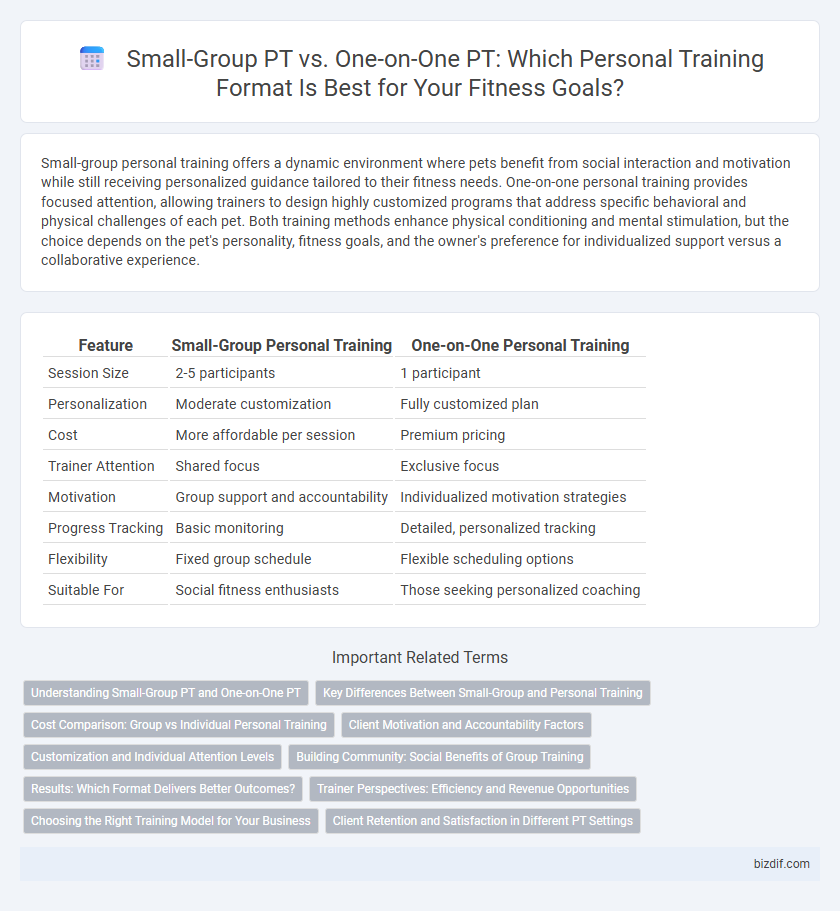Small-group personal training offers a dynamic environment where pets benefit from social interaction and motivation while still receiving personalized guidance tailored to their fitness needs. One-on-one personal training provides focused attention, allowing trainers to design highly customized programs that address specific behavioral and physical challenges of each pet. Both training methods enhance physical conditioning and mental stimulation, but the choice depends on the pet's personality, fitness goals, and the owner's preference for individualized support versus a collaborative experience.
Table of Comparison
| Feature | Small-Group Personal Training | One-on-One Personal Training |
|---|---|---|
| Session Size | 2-5 participants | 1 participant |
| Personalization | Moderate customization | Fully customized plan |
| Cost | More affordable per session | Premium pricing |
| Trainer Attention | Shared focus | Exclusive focus |
| Motivation | Group support and accountability | Individualized motivation strategies |
| Progress Tracking | Basic monitoring | Detailed, personalized tracking |
| Flexibility | Fixed group schedule | Flexible scheduling options |
| Suitable For | Social fitness enthusiasts | Those seeking personalized coaching |
Understanding Small-Group PT and One-on-One PT
Small-Group Personal Training (PT) offers a dynamic, social environment where participants share expert guidance while benefiting from personalized attention in a cost-effective setting. One-on-One PT delivers fully customized fitness plans with focused motivation, ensuring precise technique correction and tailored progress tracking. Both formats optimize workout efficiency but differ in interaction levels and individual customization.
Key Differences Between Small-Group and Personal Training
Small-group personal training offers personalized attention within a collaborative environment, typically involving 3 to 6 participants, which enhances motivation and cost-effectiveness compared to one-on-one sessions. Personal training delivers fully individualized workout plans and immediate feedback tailored to unique fitness goals, ensuring faster progress and injury prevention. The choice depends on individual preferences for personalized guidance versus social interaction and budget considerations.
Cost Comparison: Group vs Individual Personal Training
Small-group personal training typically costs 50-70% less per session than one-on-one training due to shared coaching expenses among participants. Individual personal training sessions average between $50 to $100 per hour, while group sessions often range from $20 to $40 per person. This cost efficiency makes small-group PT an attractive option for budget-conscious clients seeking professional guidance.
Client Motivation and Accountability Factors
Small-group personal training enhances client motivation through social interaction and peer support, fostering a sense of community that encourages consistent attendance. Accountability improves as participants commit not only to their own goals but also to the group's progress, increasing overall adherence to fitness routines. One-on-one personal training offers personalized attention and tailored feedback, which can boost motivation by addressing individual needs directly, but may lack the competitive and social accountability factors present in small-group settings.
Customization and Individual Attention Levels
Small-group personal training offers a balance between social motivation and personalized guidance, allowing for tailored workouts within a supportive environment. One-on-one personal training provides the highest level of customization and individual attention, enabling trainers to design programs that address specific fitness goals, injury prevention, and technique refinement. Clients seeking precise adjustments and focused feedback often benefit more from one-on-one sessions compared to the shared experience in small-group PT.
Building Community: Social Benefits of Group Training
Small-Group PT enhances motivation and accountability through shared goals and peer support, fostering a strong sense of community. Participants benefit from diverse social interactions, which promote camaraderie and create a positive workout environment. This social dynamic often leads to increased adherence and long-term fitness success compared to One-on-One PT.
Results: Which Format Delivers Better Outcomes?
Small-Group Personal Training often enhances motivation through peer support, leading to consistent workout adherence and improved cardiovascular and strength gains. One-on-One Personal Training offers fully customized programs and immediate expert feedback, resulting in faster progression and targeted injury prevention. Studies indicate individualized coaching typically yields superior results for specific goals, while small-group settings boost general fitness and social engagement.
Trainer Perspectives: Efficiency and Revenue Opportunities
Small-group personal training allows trainers to maximize efficiency by engaging multiple clients simultaneously without significantly increasing effort, boosting overall revenue through higher client volume. One-on-one personal training fosters deeper client-trainer relationships and customized programming, potentially commanding higher per-session fees but limiting the number of clients served. Balancing both formats can optimize a trainer's schedule, combining personalized attention with scalable income streams.
Choosing the Right Training Model for Your Business
Small-group personal training maximizes client engagement and cost-efficiency by allowing trainers to work with multiple clients simultaneously, increasing revenue per session. One-on-one personal training offers customized programs and individualized attention, ideal for clients seeking specialized guidance and faster progress. Businesses should evaluate client needs, trainer capacity, and profit goals to select the most suitable training model that aligns with their brand and operational strengths.
Client Retention and Satisfaction in Different PT Settings
Small-group personal training fosters a supportive community environment, enhancing client retention through shared motivation and accountability. One-on-one personal training offers personalized attention and tailored workout plans, leading to higher satisfaction for clients seeking specific fitness goals. Both settings impact client engagement differently, with small groups promoting long-term commitment and individual sessions delivering customized feedback and progress tracking.
Small-Group PT vs One-on-One PT Infographic

 bizdif.com
bizdif.com